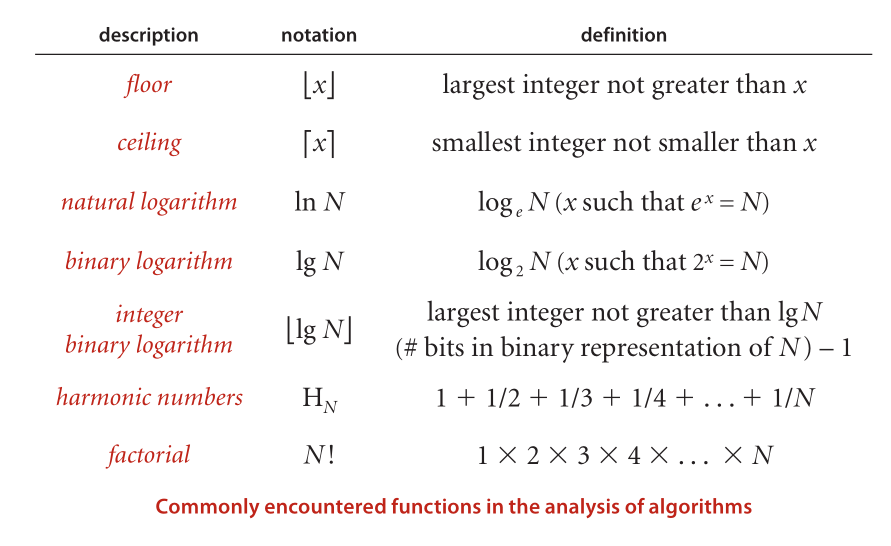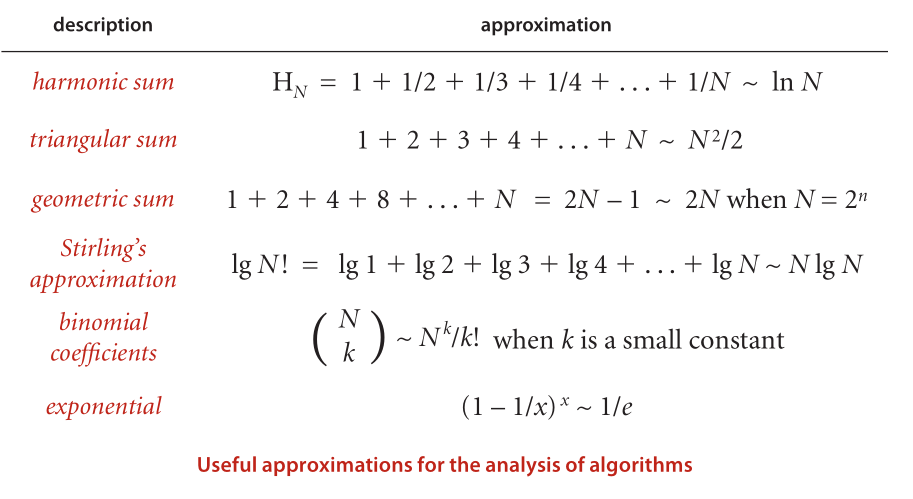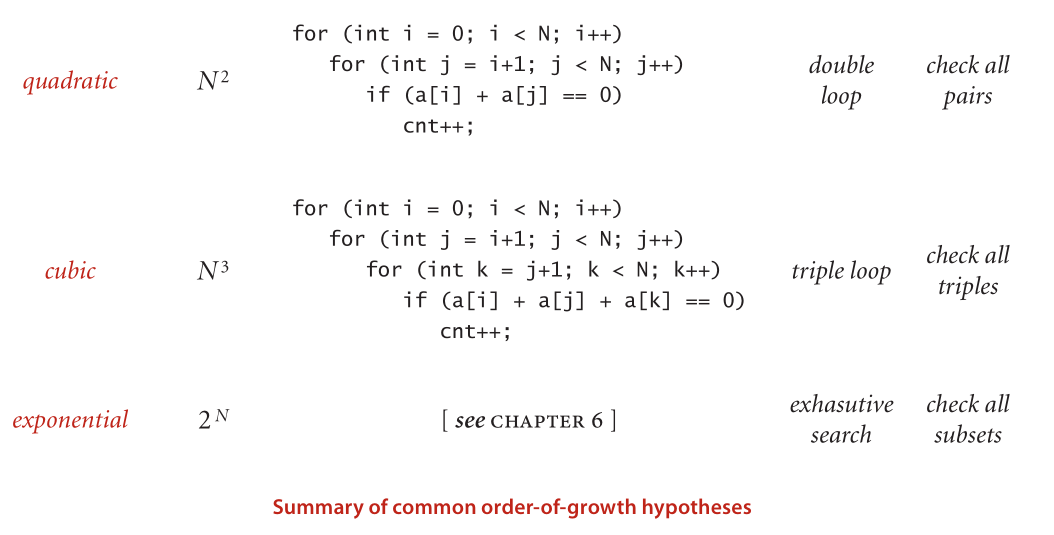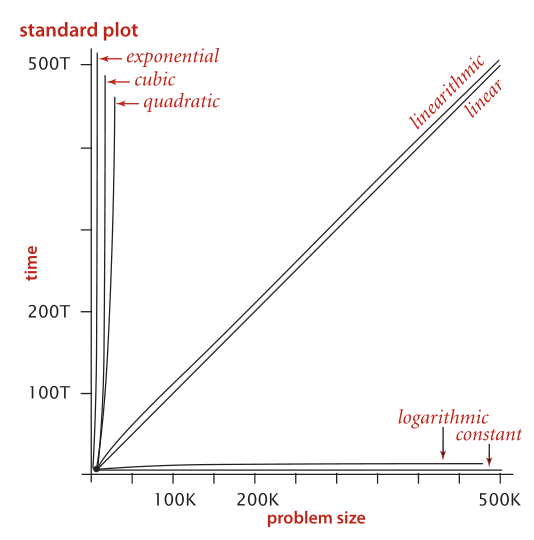算法Sedgewick第四版-第1章基础-1.4 Analysis of Algorithms-001分析步骤
2016-04-20 15:00
429 查看
For many programs, developing a mathematical model of running time
reduces to the following steps:
■Develop an input model, including a definition of the problem size.
■ Identify the inner loop.
■ Define a cost model that includes operations in the inner loop.
■Determine the frequency of execution of those operations for the given input.
Doing so might require mathematical analysis—we will consider some examples
in the context of specific fundamental algorithms later in the book.
If a program is defined in terms of multiple methods, we normally consider the
methods separately. As an example, consider our example program of Section 1.1,
BinarySearch .
Binary search. The input model is the array a[] of size N; the inner loop is the
statements in the single while loop; the cost model is the compare operation
(compare the values of two array entries); and the analysis, discussed in Section
1.1 and given in full detail in Proposition B in Section 3.1, shows that the num-
ber of compares is at most lg N ? 1.
Whitelist. The input model is the N numbers in the whitelist and the M numbers
on standard input where we assume M >> N; the inner loop is the statements in
the single while loop; the cost model is the compare operation (inherited from
binary search); and the analysis is immediate given the analysis of binary search—
the number of compares is at most M (lg N ? 1).
Thus, we draw the conclusion that the order of growth of the running time of the
whitelist computation is at most M lg N , subject to the following considerations:
■ If N is small, the input-output cost might dominate.
■The number of compares depends on the input—it lies between ~M and ~M
lg N, depending on how many of the numbers on standard input are in the
whitelist and on how long the binary search takes to find the ones that are (typi-
cally it is ~M lg N ).
■ We are assuming that the cost of Arrays.sort() is small compared to M lg N.
Arrays.sort() implements the mergesort algorithm, and in Section 2.2, we
will see that the order of growth of the running time of mergesort is N log N
(see Proposition G in chapter 2), so this assumption is justified.
Thus, the model supports our hypothesis from Section 1.1 that the binary search algo-
rithm makes the computation feasible when M and N are large. If we double the length
of the standard input stream, then we can expect the running time to double; if we
double the size of the whitelist, then we can expect the running time to increase only
slightly.







reduces to the following steps:
■Develop an input model, including a definition of the problem size.
■ Identify the inner loop.
■ Define a cost model that includes operations in the inner loop.
■Determine the frequency of execution of those operations for the given input.
Doing so might require mathematical analysis—we will consider some examples
in the context of specific fundamental algorithms later in the book.
If a program is defined in terms of multiple methods, we normally consider the
methods separately. As an example, consider our example program of Section 1.1,
BinarySearch .
Binary search. The input model is the array a[] of size N; the inner loop is the
statements in the single while loop; the cost model is the compare operation
(compare the values of two array entries); and the analysis, discussed in Section
1.1 and given in full detail in Proposition B in Section 3.1, shows that the num-
ber of compares is at most lg N ? 1.
Whitelist. The input model is the N numbers in the whitelist and the M numbers
on standard input where we assume M >> N; the inner loop is the statements in
the single while loop; the cost model is the compare operation (inherited from
binary search); and the analysis is immediate given the analysis of binary search—
the number of compares is at most M (lg N ? 1).
Thus, we draw the conclusion that the order of growth of the running time of the
whitelist computation is at most M lg N , subject to the following considerations:
■ If N is small, the input-output cost might dominate.
■The number of compares depends on the input—it lies between ~M and ~M
lg N, depending on how many of the numbers on standard input are in the
whitelist and on how long the binary search takes to find the ones that are (typi-
cally it is ~M lg N ).
■ We are assuming that the cost of Arrays.sort() is small compared to M lg N.
Arrays.sort() implements the mergesort algorithm, and in Section 2.2, we
will see that the order of growth of the running time of mergesort is N log N
(see Proposition G in chapter 2), so this assumption is justified.
Thus, the model supports our hypothesis from Section 1.1 that the binary search algo-
rithm makes the computation feasible when M and N are large. If we double the length
of the standard input stream, then we can expect the running time to double; if we
double the size of the whitelist, then we can expect the running time to increase only
slightly.







相关文章推荐
- Django之站内搜索-Solr,Haystack
- ubuntu14.04 RockMongo的配置
- Django filter符合表示"不等于"
- Django笔记 富文本编辑器 课题
- Django笔记 二级子域名配置
- Django笔记 如何扩展User表的字段
- Django之信息聚合
- 谷歌“安全浏览”检查出Google.com“存在危险”
- 谷歌“安全浏览”检查出Google.com“存在危险”
- Django之sitemap
- Go-Pholcus爬人民网新闻规则
- Go语言解析JSON
- golang入门-- import包与包内init方法的执行时机
- django的session保存策略(时间)
- Google Cardboard 虚拟现实眼镜开发初步(一)
- 当你在浏览器中输入Google.com并且按下回车之后发生了什么
- 在Windows下使用Django创建第一个项目
- 记一次Golang routine卡死
- Google Guava 库用法整理
- Django之便签生成
